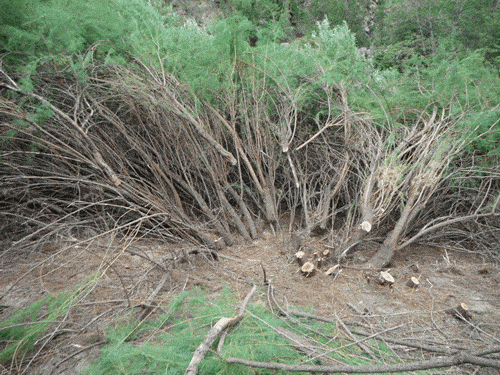
Tamarisk Eradication
To further our mission of protecting the Gila River and Gila National Forest, UGWA has been working on tamarisk eradication since 2016. Invasive species such as tamarisk often outcompete willows, cottonwoods, and other native riparian vegetation that wildlife depend on for food, cover, and nesting sites. Tamarisks dominate the heavily managed and dewatered Gila River in Arizona, and we’re working to prevent a similar biological dead zone from happening here.
Because the Gila River through the Gila Wilderness largely retains its highly variable flows to which native willows and cottonwoods are adapted, tamarisks occur only in isolated stands, making this an ideal time to knock them back before they take over. UGWA is working to eradicate tamarisk on the Gila River in the Gila Wilderness and farther downstream in the Gila River Bird Area.
In the Gila Wilderness, tamarisk eradication is labor-intensive work because the trees can only be reached on foot or horseback, and they often need to be treated a couple of times before they give up the ghost. In the past few years, we’ve treated the Middle and East Forks of the Gila River and surveyed the West Fork – there weren’t any – and the 40+ mile stretch of the mainstem Gila River through the wilderness area.
Thank you to the National Forest Foundation and the Native Plant Society of New Mexico for funding tamarisk eradication. The National Forest Foundation works on behalf of the American public to inspire personal and meaningful connections to our National Forests. The Native Plant Society of New Mexico fosters plant conservation and the preservation of natural habitats.

Wilderness Trail Maintenance
Trail maintenance in the Gila National Forest is more important than you might initially think. Besides being a pleasure to hike, a well-planned and maintained trail lowers the risk of hikers getting injured or lost. In addition to promoting public safety, trails in good repair protect the health of the land and water. Unmaintained trails cause excessive erosion and send sediment into streams where it degrades aquatic habitat.
That’s why UGWA is working on trail maintenance in the Gila National Forest, mostly in the Gila Wilderness. We’re collaborating with wilderness trails expert Melissa Green and volunteers from the Gila Chapter of the Back Country Horsemen, Continental Divide Trail Coalition, and other stalwart workers. In the last two years, with the help of about 150 volunteers working more than 5,300 hours, Green and crew brushed out trails, used handsaws to remove logs (chainsaws are prohibited in wilderness), did tread work, placed cairns, and repaired signage on 90 miles of trail. That’s a very impressive accomplishment!
For current information on cleared trails, visit the Gila Trails website at http://www.gilatrailsinfo.org/ or Gila Trails Info Facebook page https://www.facebook.com/gilatrailsinfo
Thank you to the National Forest Foundation for funding trail work. The National Forest Foundation works on behalf of the American public to inspire personal and meaningful connections to our National Forests.